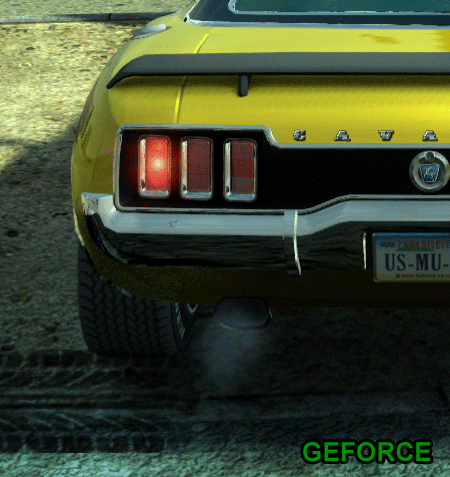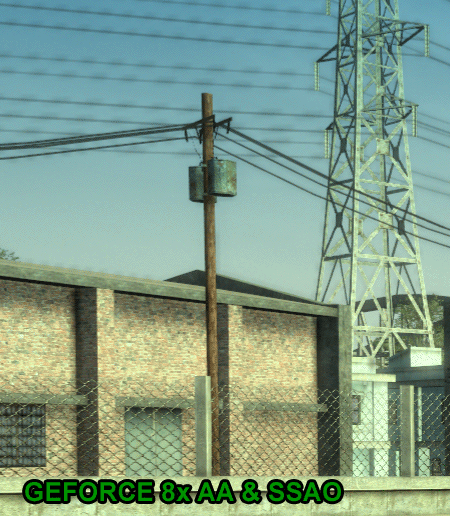Burnout Paradise: The Ultimate Box, Performance Analysis
Image-Quality Settings
It turns out that Burnout Paradise is easy to run, especially considering how darn good it looks. Because of this, we have set all of the visual-quality settings to their highest levels for all our tests, except for the Screen Space Ambient Occlusion (SSAO) feature. We only enabled SSAO in its own dedicated benchmark comparison.
Image Quality: Radeon vs. GeForce
First off, we took a few screen shots from the Radeon HD 4850 card and compared them to results we got from a GeForce GTX 260. At first glance, the image quality appears absolutely identical, without anti-aliasing (AA), with 8x multi-sampling anti-aliasing (MSAA) enabled, and then with SSAO enabled:
Upon closer inspection, we start to see some noticeable differences during game play. The one that stands out the most is the shadow quality of the car's rear spoiler. On the Radeon cards, this shadow appears clean, but on the GeForce cards, the shadow has banding artifacts, as if it's a lower resolution than the Radeon's shadow.
Other differences appear with a little more scrutiny. The GeForce cards, for example, seem to display deeper-and-darker shadows such as the one under the player's car. The Radeon shadows appear lighter and paler in comparison.
We can also see some differences in the way the buildings are affected by light. There appears to be some brightness/contrast fluctuations on certain objects, but there's nothing else of real note. The 8x AA quality seems right on par for both cards.
The good news is, on the whole, it really doesn’t matter from which vendor your graphics card came if you’re worried about image or AA quality. The only issue we ever actually noticed while playing was the banding shadows on the player's car, and this isn't going to make or break your gaming experience.
Get Tom's Hardware's best news and in-depth reviews, straight to your inbox.
SSAO Visual Setting: What is it and what can it do?
SSAO is the new buzz word in modern 3D engine lighting realism, pioneered in the once-bleeding-edge title Crysis. Simply put, ambient occlusion is an illumination algorithm that simulates many aspects of ray tracing. It can illuminate the entire scene globally, while highlighting the way that light has a difficult time penetrating confined or closed spaces, such as cracks. The bottom line is that lighting looks much more realistic with the ambient occlusion setting turned on.
Unfortunately, it’s not all good news. The method that Burnout Paradise uses to render ambient occlusion causes a strange dark halo effect around thin items in the scene. It’s especially distracting on items like railings and telephone pole wire. When enabled, it also causes a massive frame-rate hit as we will see later in the benchmarks.
Here's an example of SSAO. The SSAO feature seemed to work similarly between the GeForce and Radeon cards, aside from the brightness differences they already exhibited:
Don Woligroski was a former senior hardware editor for Tom's Hardware. He has covered a wide range of PC hardware topics, including CPUs, GPUs, system building, and emerging technologies.
-
cruiseoveride Where is the people's champion? The HD4870?Reply
I felt the lighting looked a little more natural on the geforce. The colour on the radeon looked better though -
IzzyCraft I like the nvidia shadows more makes it less bland look imo a more definitive look which i like.Reply
I was wonding why no 4870 like above.
SSAO on :) reminds me of ripping dvd's and messing with sharpness, debanding etc the telephone wire atleast. -
enterco Considering how 'hardware friendly' is this game, probably it will be very successful.Reply
-
SpadeM The first screen shot comparison is quite tricky :) on the first look you might think the geforce does not render the red car at all.Reply -
ufo_warviper Nice article so far. I'm still reading the article, but I just wanted to point out that on page 7 of this review, I think the author somehow confused (a couple times) the 4830 with the 4850, and also the GTS 250 with the GTX 260 cards.Reply
With the resolution increased to 1920x1200, only the Radeon HD 4830 and GeForce GTS 250 barely pass the playable standard with over 30 FPS minimum frame rates.
Clearly, he meant the other cards here. -
IzzyCraft SpadeMThe first screen shot comparison is quite tricky on the first look you might think the geforce does not render the red car at all.A roll over png or jpg would have probably done better then the color restrivie .gif that was used, Shame that IE8 doesn't support APNG like opera and ff does, it would def make the format much more popular.Reply -
chyll2 I really like the additional benchmark that imitates different number of cores and clocks. It gives us an idea of performance we would get on similar specs with our system.Reply
-
linaaslt Somehow i missed benches from hd4770 or 4870/4890 and gtx275. but maybe it's because this game doesn't require good GPU to be playable.Reply -
zehpavora I think that, if you want to play this game with 8x MSAA, 8x AA, and High settings, a GTX 275 SLI will work. This game must be amazing at those settings! I like Race Games too, but NSF also lost me on Pro Street. I hope Burnout delivers what EA couldn't...Reply -
DjEaZy Phenom 940 @ 3400 HD4870 core@790 GRAM512Mb@4400MhzReply
2x2GB 1066Mhz 5-5-5-15
this all on 22"@1680x1050 all fx crankt up...
50~100fps



